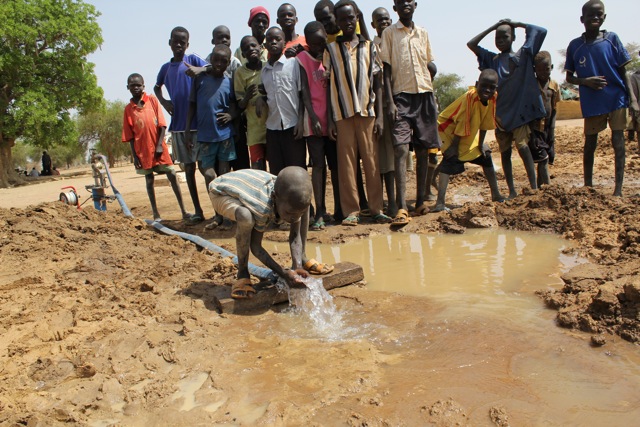Northern Bahr el Ghazal (NBeG) is reported to be the poorest area of South Sudan… and I believe it.
The state has a severe lack of infrastructure. Because of the war, and environmental conditions such as regular flooding and droughts, there has been little progress in terms of development.
We work closely with many partners to implement our program, including Water and Education offices at both state and local levels. Although there is a major dependence on international assistance for the most basic of services, these government agencies are doing their best to alleviate the suffering of their people, who are emerging from decades of trauma.
This week, we stopped by the State Ministry of Education to give them a report on our activities. The Senior Inspector of Schools and the Director of Planning and Budgets warmly greeted us. They wanted very much to discuss the water crisis at the schools. They explained that they were very concerned that schools were scheduled to start back in session in a few weeks and the entire area was still extremely dry. Without available water at the schools, clean or not, they were not sure how the children would be able to endure the average heat of 105°F (which can escalate to 118°F), at their outdoor classes.
The children in most of these schools are studying under trees and in huts, rather than in classrooms, so they are easily distracted. It’s a problem if it’s too dry; it’s a problem if it’s too wet. From our early assessments, I knew that teaching under these extreme conditions is a real challenge.
With conditions like this at the schools, there is little incentive for families to even send their children to school, usually if just some of the children are allowed to attend school it is the boys who are favored. Most schools do not have water or toilets. There is also a cultural tendency to keep children at home, once they reach a certain age, to tend the animals, dig the gardens, fetch water and perform domestic duties.
It is hard to over exaggerate the desperate water situation in this area. And although the need for this crucial resource is very high on everybody’s priority list, the unfortunate reality is, education is not as high, especially in the villages. From our past experiences, we are hopeful this water will serve as an incentive to encourage these families to send their children to school, especially the girls.
Our field team spent the past three months diligently assessing schools, mobilizing the communities and getting MOUs signed to define everyone’s responsibility in relation the construction and management of the wells. The drillers were busy in the field, progressing at about one well a week.
I was eager to get into the field myself and see how things were moving along. I wanted to find out which of our strategies were working and get input from the field crews on where we might want to make adjustments.
When we arrived at the first school, water was flowing! The hand pump was not yet installed, but the drillers were pump testing to determine the hourly yield of the well. Yet, that was no deterrent to the many children who could not stay away from the excitement of fresh water. It was hot and they were very happy. The local women were already filling their containers with water as the head teacher and community members were monitoring everything and assisting with any needs of the drillers. It was a happy day for all and a beautiful sight to behold.
Although dozens of families had left their homes and migrated to the swamps for relief during the December through April dry season, school was scheduled to start soon and they would be returning.
In December, before the villagers left the area, we mobilized each of the communities to explain the project and sign the MOUs. Now, we were just waiting for the families to return so we could form the Water User Committees which consist of men and women from the village; draft By Laws for how the water point would be managed to ensure sustainability; elect a caretaker, and conduct hygiene training.
Engaging the villagers in their ownership, and the decision-making processes surrounding the wells, is essential to enhancing their capacity to help themselves and facilitate change.
We have a big job ahead of us as we try to convince these communities of the importance of education. Thankfully, we are gaining their trust with our first step, providing this much-needed water. There is no denying that safe water and good hygiene practice keep children healthy. And healthy children have healthy minds. This region needs those healthy minds as it strives to pull itself up and move forward.
Sometimes this work seems tough and thankless, the days are long, the weather is oppressively hot and the task seems immense. But just when you are feeling like everything is a struggle, you have a day like this and see just how much of an enormous impact clean water is going to have on the day-to-day lives of this community and school, and it equally inspires us to move forward.

